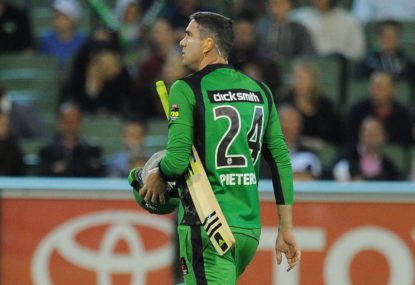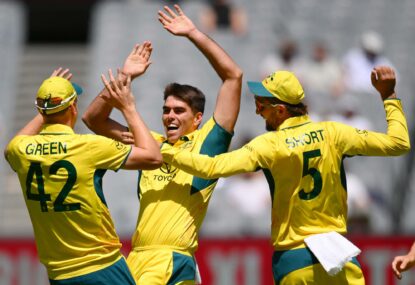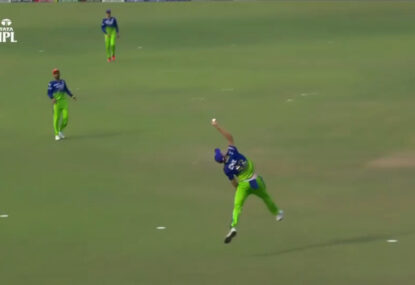The red and gold pastels of an unprepossessing Royal Challengers away strip are seen wandering the verdant alleyways of Bangalore as the sun descends on yet another scorching summer’s evening.
The orangey-pink hues of a dirt stain sustained in a last-gasp dive for the crease on 99 contrasts the golden lion of the RCB crest.
All the while, Virat Kholi raises his bat for the third time in as many games. The BCCI basks in all its glory, roping in excess of 1194 crore from the IPL cash cow that has transfixed a nation.
Kevin Pietersen, mic’d up, fresh from a stint in the Caribbean Premier League, becomes a clairvoyant to an enraptured national audience of 1.3 million by predicting the line and length of a Gurinder Sandhu delivery, before promptly depositing it into the densely populated midwicket stands of Australia’s coliseum, the MCG.
The naysayers of the T20 format have long scoffed at its ability to flaunt itself around the international market with unwavering success. The palpable atmosphere emanating from the hoarse diaphragms of 40,000 frenzied Indian cricket diehards inside the M. Chinnaswamy Stadium on IPL finals day is exclusive of franchise fandom, and representative of T20’s success.
A county side is seldom exposed to such ebullient support that its excellent standard deserves.
While the T20 cricket product appears to have reached the summit, capturing the hearts and minds of those most malleable – chiefly children and adolescents – England’s premier T20 competition continues to meander along with subdued significance, yet to tap into the successes of franchise cricket. But is this the route the T20 Blast should follow?
Does the current format require a total revamp? Does the rich history of English cricket embed fans with a refined palate that rejects T20 cricket? How can viewer apathy be improved?
These are the questions that must be asked by the powers that be on the English Cricket Board. The Blast must cease resting on its laurels if it is to awaken from a slumber that has seen it slip five years behind a thriving pack.
T20 is the profit centre for cricketing boards worldwide, yet the current tournament has well and truly missed the boat of financial nirvana. As it stands, the T20 Blast lies on shaky foundations, whose rotting is the result of something far from the perceived fan reproof.
Perhaps the ECB are not buoyed by the same imperatives as the BCCI, namely revenue. For this it should be admired. Money hungry boards are the foibles of cricket’s enduring character. Though, a competition based on privatised franchises – serving the county game its own commercial value – is like dangling a carrot in front of a board who is owed a combined £7.8 million from the counties, which is exactly the case.
Therein lies the confliction; county prestige and the greater good of the game versus commercial appeal, garnered from a city-centric based competition.
For all intents and purposes, the pros of a franchise-based competition offers a cornucopia of benefits for the county game. But English cricket is a special case. It places more value, more merit in domestic cricket than any of its cross-country colleagues.
Straying from its roots, which predate the 18th century, would prompt a crisis of significance for the domestic competition, as the counties stare down the malignant glare of the new kids on the block. A misalignment of expectations between the three formats will leave the summer of cricket with emphasis on its shortest form.
An oversight of such proportions would see one-day and championship cricket gasping for air in an environment bereft of oxygen. Australia’s witnessed it, so has India and New Zealand. The last recorded attendance of the Sheffield Shield in the 2011-12 summer saw a total of 4809 people through the gates. More concerning was the One Day Domestic competition’s figure of 4033 (total) in 2015-16.
Dwindling attendance happens to align itself with the beginning of the Big Bash League. Coincidence? Perhaps. It’s an issue that continues to confound the most ignorant eye.
Yet maybe this trend is indicative of cricket’s 21st century forecast – a world dominated by the shortest form – and hence should be unduly embraced.
The championship’s viewership figure in the summer of 2015, 513,000, attests the need for the ECB to conform to its current T20 format – with the implication of vast remodeling to raise attendance – so not to distract heavily from the championship. A city-based competition would momentarily amuse, before shuddering down to earth with a resounding clatter.
Perhaps most importantly, though, it must avoid the well-trodden path that has seen our Shield competition wistfully slip down the drain of inferiority through taking a reluctant backseat to the Big Bash. It’s not out of line to state that England’s domestic competition can achieve a kind of attendance parity across all formats if it resists its city-based entity.
So where does that leave us? Last year’s T20 Blast finals day produced the worst viewing audience since the competition’s inception in 2003. Just 388,000 people parked themselves in front of the TV to watch the tournament’s flagship event.
Clearly that’s a message that the ethos of the Blast is failing to sink in. So how does a jetlagged competition improve without stepping into the T20 twilight zone that is franchise cricket?
The short answer – high-profile international players. Fans crave the battles of T20 that have them leaving the stadium with bated breath. Their appetite should be fed with an influx of international talent, serving two obligatory purposes.
First, enhancing the Blast’s international and local appeal and secondly, exposing England’s future stars to superlative cricketing craftsmen, thus enhancing their skills.
Take the game between Sussex and Somerset last week for example. On a ground that embodies the culture of county cricket, Hove, the indisputable hitting talents of Chris Gayle were tasked with taking down the searing pace of the now T20 specialist and England hopeful, Tymal Mills.
Ninety miles per hour against a man, proclaimed ‘world boss’, whose sole purpose it seems is to send bowlers back to the team hotel with nightmares. An x-factor that’s seen him amass some 2335 runs as a freelance T20 cricketer.
These battles rouse the fan-base. Though, 18 counties playing in one competition spreads the spattering of international cricketers particularly thin, meaning some counties are bereft of an import causing a gap between the standards of the sides.
Though it’s far from the only global T20 competition guilty of this, length is an inherent downfall of the Blast. A tournament played over three months quickly becomes fatigued, failing to pique the zeal of the fan throughout the competition’s entirety, consequently depriving the points table of meaning and significance until the finals roll around.
The Blast morphs into the first day of a championship match, then into the one-day cup before a rampant, English Test side subsequently diverts the interests of the cricketing fraternity. This issue has been duly addressed by the ECB, with the 2017 edition of the Blast played over two months during the school holidays.
Even then, the typically hyped clashes must take precedence to clone overseas franchise success without losing sight of their heritage; the battle of the roses at an overpopulated, rambunctious Old Trafford or Middlesex-Surrey at Lord’s.
The Big Bash League has recently found success from its contrived intra-city franchise rivalry, aptly named the Melbourne derby. 80,000 fans saw an encounter between the two sides at the MCG just last year.
Franchise cricket doesn’t fit the bill as far as county cricket is concerned. The Blast will develop through improved scheduling, exposure and international player endorsement.





































































































